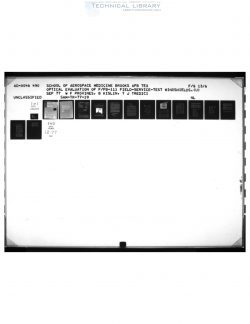SAM-TR-77-19
- Version
- 144 Downloads
- 5.72 MB File Size
- 1 File Count
- March 7, 2017 Create Date
- March 7, 2017 Last Updated
Optical Evaluation of F-FB-111 Field Service Test Windshields

This report describes the principal effort by the USAF School of Aerospace Medicine (USAFSAM) in support of the F/FB—III bird—impact— resistant windshield field—service- test program (Air Force Flight Dynamics Laboratory Project 1426- 75—01 and Tactical Air Command Project 75c-126W) . The F/FB—III windshield design is rather atypical for flight craft in that it consists of tvo windshields forming a cone section installed at 68 degrees from vertical and viewed through an oblique angle by the aircrew (Fig. l) .
A more serious windshield concern arose In the form of destructive birdstrlkes. Because of Its high—speed, low—level mission require— ments, the F/FB—III has a high probability In encountering birdstrikes of enormous Impact force. When a number of strikes occurred on the 0.85—cm (0.33—in) thick, 3—p1y, chemically tempered glass windshields, catastrophic vindshleld failure occurred vlth bird penetration; and aircraft loss resulted In some Instances. Concerned about this loss potential, the U.S. Alr Force requested the development of a wind— shield that vould survive a birdstrike at mission profile and velocity (TAC "Required for Operational Capability" (ROC) "26—71) . Pittsburgh Plate Glass (PPG) Industries, under contract award, developed a windshield, approximately 2.54 cm (l In) thick, Of a 10—p1y design composed of acrylic, polycarbonate, and proprietary Innerlayers. The structural properties of this windshield vill defeat penetration in a high—speed bird Impact. The Alr Force Flight Dynælcs Laboratory (AFFDL) development program manager vas directed to field—test ten shipsets of the PPG windshields for approximately I year before receending full—fleet retrofit. The purpose of the field test vas to evalv•te the envirormental effects upon the unproved plastic materials an. to moni tor aircrev acceptance of potential optical—error characteristics imparted In the manufacturing process.
| File | Action |
|---|---|
| SAM-TR-77-19 Optical Evaluation of F-FB-111 Field Service Test Windshields.pdf | Download |

Comment On This Post